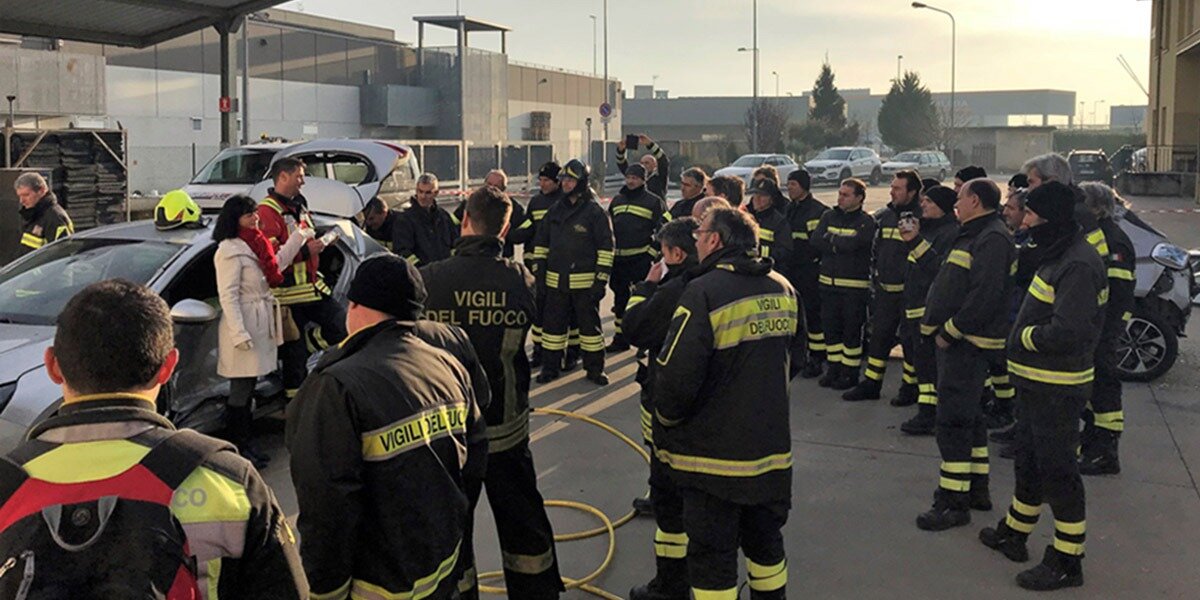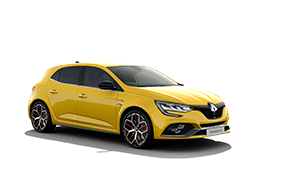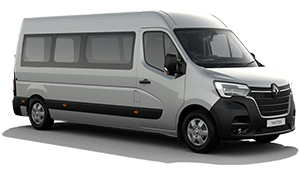
How an in-house firefighter helps Renault Group’s engineers improve safety for all
- Renault has been part of a unique collaboration with firefighting services since 2010, committed to improving safety for all
- Renault Group is the only car manufacturer to work with road rescue teams to facilitate their work in the field
- The rescue teams help inform Renault engineers with their designs, and also enables the rescuers to understand the very latest developments and innovations in the automotive industry
- Christophe Lenglos, Lieutenant-Colonel in the Yvelines Fire and Rescue Department, has been assigned to Vehicle Safety division at Renault Group Engineering’s customer performance department
- Here he talks through how his involvement has improved the response time of rescue teams when they are called on, including innovative developments such as ‘Fireman Access’ on EV and hybrid vehicles
Since 2010, Renault Group has been part of a unique collaborative project to support the work of firefighters when responding to an accident. That’s why it’s not unusual to see firefighters at the Renault Group technical centre in Lardy or the Technocentre in Guyancourt, in full kit and ready to leap into action. There’s no emergency, they’re just involved in training drills.
Christophe Lenglos is the Lieutenant-Colonel of the Yvelines Fire and Rescue Department, but is also weaved into the Group’s engineering department, to help inform what rescue teams must deal with in the event of an accident. He says:
"Following a violent accident involving major trauma, the ‘golden hour’ is the hour that follows the initial crash. Every minute counts. Our primary goal as first responders is to save as much time as possible with each call-out.”
His involvement has led to some key innovations in Renault’s electric and hybrid vehicles thanks to this unique knowledge-sharing collaboration.
Safety has been key for Renault for more than 60 years
Renault Group and road safety is a story that spans more than six decades, back to when one of the company’s doctors, Dr. Claude Tarrière, set up the accidentology and biomechanics laboratory.
Over the decades, while the brand's vehicles have become progressively safer for those on board, they have also become increasingly complex, especially for emergency services. In 2010, driven by its commitment to improve safety, Renault Group – through its Corporate Social Responsibility department – decided to work closer with road rescue services in developing ways to better save lives.
The notion of tertiary safety, an area focused on making road rescue operations safer, faster, and more efficient, took on full meaning within the group. It is the next step after primary safety (all systems that help prevent accidents or reduce their consequences) and secondary safety (everything that protects passengers during an accident).
Modern cars are rapidly changing, therefore rescue operations need to adapt to keep up. When the first electric vehicles hit the market, Renault Group stepped up collaborative efforts with the fire and rescue services. In turn, rescue services came to see Renault Group as not just a car manufacturer, but also a major ally.
In 2018, Christophe Lenglos, a ranking officer from the Yvelines Fire and Rescue Department, was assigned to the Renault Group R&D Technocentre. Since then, Lieutenant-Colonel Lenglos has worked alongside Claire Petit-Boulanger, Tertiary Safety Expert who started at the CSR division.
Claire Petit-Boulanger says: "Our partnership serves three main purposes. First, we work with the people in Engineering and vehicle development daily to ensure they are aware of the constraints and needs of emergency services. We also take the knowledge that we have acquired within Renault Group and share it with first responders in France and abroad through firefighter training sessions.
Lastly, we promote Renault Group’s involvement with emergency workers before the French Ministry of the Interior (DGSCGC) and international organisations (such as Word Rescue Organization, International Emergency Firefighters), so that emergency services will have the best possible support when dealing with new vehicles in the future.”
A duo with a lot to learn from each other
Vehicle extraction exercises and training sessions are often held by teams from Renault Group Engineering and Tertiary Safety. These exercises aim to give local fire and rescue squads real-life practice in dealing with post-crash scenarios involving new vehicles before their official release on the market. This approach is an essential step in validating the Decision Support Sheets (DSS) that Euro NCAP* has recently added to its list of requirements.
"My role is primarily to work with engineering teams during the early stages of design to ensure they understand and incorporate what road rescuers need in their designs. It is also beneficial for fire fighters as it keeps us abreast of the technological advancements and constraints an automotive manufacturer must account for in vehicle design, therefore enabling us to make emergency services more efficient and better adapted," outlines Christophe Lenglos.
The passive safety division in Lardy provides these kinds of opportunities thanks to its fleet of post-collision vehicles. Claire Petit-Boulanger, Tertiary Safety Expert at Renault Group Engineering, says: "Renault Group gives firefighters the opportunity to use test car prototypes so they can practice on new generation vehicles. More than 500 of the Group’s most recent models are used every year to improve vehicle extrication and road rescue techniques.”
For Christophe Lenglos, sharing knowledge of best practices is crucial: "Thanks to our collaboration with Renault Group, we now have up-to-date knowledge. The expertise of engineers is reassuring as we sometimes have misconceptions about certain perceived dangers that are far more manageable than we previously thought.”
Particular attention has been paid to electrified vehicles (hybrid, plug-in hybrid, and EV) that now make up a significant number of the Group’s products. "Thanks to experience in electric vehicles that Renault Group has been acquiring over more than 10 years and its work on battery chemistry, we have developed an informed approach to rescue operations that are well adapted to such vehicles” explains Christophe Lenglos.
Innovation that improves safety for all
This unique collaboration has been beneficial for everyone involved. For Renault Group, it has given rise to two innovative solutions that have both helped emergency services considerably reduce their response time.
First, ‘Fireman Access’ gives firefighters fast and direct access to a burning battery on Renault Group hybrid, plug-in hybrid and electric models. The special access means that a team can get water into the heart of EV batteries to extinguish fires in just five minutes, instead of one to three hours of firefighting. The patented innovation received the Renault Brothers GOLD Trophy from Luca de Meo on 1st July.
The second innovation is the inclusion of a QR code located on windscreens that can be scanned by emergency services, giving them all the technical specifications, they need for their rescue operations. The information is compiled and included on the FAD rescue sheet. When rescue teams arrive at an accident site, the easily recognisable QR code can be rapidly scanned to determine if the vehicle is an EV, HEV, or PHEV model.
On top of this information, emergency services also receive details on the car’s architecture, in particular, battery and air bag locations, and the ideal spots that are quickest and safest to cut through. This type of information is vital at the scene of an accident as it improves response times. For example, it can help save 15 minutes when extracting someone from a crashed vehicle, potentially helping to save a life.
Originally devised by Renault Group, the rescue sheets initiative has also helped change road safety in general, as they are now required by Euro NCAP in allocating its star ratings. The QR codes will appear on all Renault Group vehicles in Europe as of 2022.
The specific constraints of electric and hybrid vehicles
Electrified vehicles pose an additional challenge of electrical safety, that fire and rescue teams must account for when drafting operational procedures.
For ICE vehicles, the usual step involves securing the regular 12V/14V battery. With electric or hybrid vehicles, given that impact speeds are often above those tested by Euro NCAP protocols, the high-voltage battery (400 volts) and its power cables must be made safe. This operation must be done as safely as possible without slowing down efforts to rescue people inside the vehicle.
For high-voltage batteries, a wide range of manual safety mechanisms can be found in different locations depending on the manufacturer: boot, engine block, under a seat, etc. These rescue sheets are of paramount importance for firefighters.
As part of Renault Group's ongoing work with the emergency services, the Renault and Dacia vehicle design teams have ensured that all cables built into the car’s body are not located in areas that emergency services are most likely to cut through when extracting passengers.
Much like circuit breakers in household electrical circuitry, Renault Group EV models are also equipped with a ‘breaker’ to easily stop all electricity flowing through the vehicle. A prime example of making the breaker switch as easy to access as possible is how it has been placed in the front passenger footwell on Renault Zoe models.
Experience and training exercises in France and around the world
Renault Group understands the importance of how this kind of experience and expertise can be and has extended its work with fire and rescue services in several locations. In addition to France, countries such as Italy, Portugal, Switzerland, Slovenia, Croatia, Finland, Canada, and Colombia are all increasingly interested in training sessions that hone their skill sets and provide valuable insights into major changes going on in the automotive industry.
The Group engineering division is keen to capitalise on high-tech digital simulation and virtual reality tools to facilitate the training that’s required. The aim is to give firefighters the opportunity to train on new generation vehicles with immersive virtual reality simulations that accurately reproduce structural deformations that occur in accidents, effectively replicating practising on real vehicles to make sure that every minute counts.
*Euro NCAP: The European New Car Assessment Program is an independent international organisation created in 1997. Its main mission is to carry out impact tests to assess the passive and active safety of vehicles. The safest vehicles on the market receive a maximum rating of 5 stars.
***
About Renault Group
Renault Group is at the forefront of a mobility that is reinventing itself. Strengthened by its alliance with Nissan and Mitsubishi Motors, and its unique expertise in electrification, Renault Group comprises 5 complementary brands - Renault, Dacia, LADA, Alpine and Mobilize - offering sustainable and innovative mobility solutions to its customers. Established in more than 130 countries, the Group has sold 2.9 million vehicles in 2020. It employs more than 170,000 people who embody its Purpose every day, so that mobility brings people closer. Ready to pursue challenges both on the road and in competition, Renault Group is committed to an ambitious transformation that will generate value. This is centred on the development of new technologies and services, and a new range of even more competitive, balanced, and electrified vehicles. In line with environmental challenges, the Group’s ambition is to achieve carbon neutrality in Europe by 2050. https://www.renaultgroup.com/en/
Recent Posts
-
 SCENIC E-TECH ELECTRIC VOTED EUROPEAN CAR OF THE YEAR 202428th February 2024
SCENIC E-TECH ELECTRIC VOTED EUROPEAN CAR OF THE YEAR 202428th February 2024 -
 RENAULT 5 E-TECH ELECTRIC27th February 2024
RENAULT 5 E-TECH ELECTRIC27th February 2024 -
 CELEBRATING 125 YEARS OF RENAULT26th February 2024
CELEBRATING 125 YEARS OF RENAULT26th February 2024
All Posts
View All
2024
2023
2022
- 2022 - December (1)
- 2022 - November (1)
- 2022 - October (4)
- 2022 - September (1)
- 2022 - August (1)
- 2022 - June (2)
- 2022 - May (2)
- 2022 - April (1)
- 2022 - March (1)
- 2022 - February (1)
- 2022 - January (2)
2021
- 2021 - December (1)
- 2021 - November (4)
- 2021 - October (4)
- 2021 - September (1)
- 2021 - August (1)
- 2021 - April (1)
- 2021 - February (1)
- 2021 - January (3)









